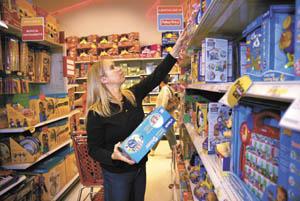WARNING! : Christmas toys may contain small parts that present a choking hazard for children
Published 12:00 am Monday, December 4, 2006

- Photo by Lara Cooper/Daily NewsPamela Gray of Bowling Green searches at Target for the perfect toys for her twin grandchildren, Alexis and Samuel Gray. “Safety is a concern when I'm shopping for their toys,” she said of the 6-month-olds. “They're at an age when they're reaching and grabbing for everything.”
It’s the time of year when long wish lists of toys magically appear in parents’ laps.
You’d like to get the most desired gift, but how do you know it’s safe for your child?
Trending
“Just because your child wants a particular toy, that doesn’t mean he’s ready for them,” said Melanie Napier, a health educator for the Barren River District Health Department.
While a bag of marbles may have a tag warning that it shouldn’t be given to a child younger than 3, for example, that doesn’t mean all 3-year-olds are ready for marbles, which can be a choking hazard.
“You know if your child is going to stick that marble in his mouth,” Napier said.
Vicki Poore, coordinator of the Safe Kids Coalition at the Barren County Health Department, said it’s extremely important to buy age-appropriate toys.
“Ninety-eight percent of the kids seen in hospital emergency rooms are (there because of) toy-related injuries,” she said.
Poore said children under 3 are at a greater risk for choking on toys than other children.
Trending
“They should never play with toys that have strings or straps or long cords that are longer than seven inches, because they can strangle themselves,” she said. “Small children should never play with balloons or small balls because they can choke on those. And for a child under 3, one of the things we use (as a recommendation) is if a toy fits in a toilet paper roll, it’s too small for the child to play with.”
Napier said balls or marbles for young children should never be less than 1.75 inches in diameter.
According to Poore, children under 8 should never use toys with electrical plugs or batteries due to potential burn hazards.
“And of course you know children should always use protective gear while riding wheel toys,” she added. “They need helmets and knee pads.”
Napier said even art supplies should be checked to make sure they’re safe.
According to the U.S. Consumer Product Safety Commission, parents should “look for ‘ASTM D-4236′ on art materials like crayons and paint sets; this code means the product was reviewed by a toxicologist and, if necessary, labeled with cautionary information.”
Checking art materials for safety wasn’t something Napier thought about when her kids were little, she said.
“I bought my kids markers and probably bought the least expensive (because of) the way my daughter went through them,” she said.
A high price, however, doesn’t equal a safe toy.
Last month Target recalled various Kool Toyz brand toys, including a Truck Carry Case in the $10 to $20 range due to lead and laceration hazards. Tiffany and Co. in July recalled rattles that cost about $195 each and were made of nine linked sterling silver balls containing small beads because “the seams on the rattle can open during use, releasing small round beads,” according to the USCPSC Web site at www.cpsc.gov.
The beads in the rattle, according to the Web site, “can pose an aspiration hazard to young children. The breakage also can create ragged edges on the ring, posing a laceration hazard.”
Bob Izarry, toys manager at Target in Bowling Green, said Target always works quickly to get toys that have been recalled off shelves. The store also offers a refund on recalled toys.
“They’re very quick about when there is a recall, the item is blocked out of the system,” he said. “If there’s a toy that’s not safe, we don’t want to sell it – it’s about the safety of our guests and I’m just glad there’s a company (like Kool Toyz) out there that’s realized there’s a toy (isn’t) safe.”
Napier suggests parents go to www.cpsc.gov to see the toys that have been recalled because of safety concerns.
“My kids are older,” she said, “but when they were younger, if I’d have had access to the Internet, I probably would have done that.”
Toy Safety Tips
While keeping in mind a child’s age when it comes to toys, also keep in mind his or her interests and skill level.
Look for quality design and construction in all toys for all ages.
Make sure all directions or instructions are clear – to you, and, when appropriate, to the child.
Plastic wrappings on toys should be discarded immediately.
In addition to heeding age recommendations on toys, look for other safety labels, including: “flame retardant/flame resistant” on fabric products and “washable/ hygienic materials” on stuffed toys and dolls.
Check all toys periodically for breakage and potential hazards. A damaged or dangerous toy should be thrown away or repaired immediately. Edges on wooden toys that might have become sharp, or surfaces covered with splinters, should be sanded smooth. When repainting toys and toy boxes, avoid using leftover paint, unless purchased recently, since older paints may contain more lead than new paint, which is regulated by CPSC. Examine all outdoor toys regularly for rust or weak parts that could become hazardous.
Teach children to put their toys safely away on shelves or in a toy chest after playing to prevent trips and falls.
Toy boxes, too, should be checked for safety. Use a toy chest with a lid that will stay open in any position to which it is raised, and won’t fall unexpectedly on a child. For extra safety, be sure there are ventilation holes for fresh air. Watch for sharp edges that could cut and hinges that could pinch or squeeze.
See that toys used outdoors are stored after play – rain or dew can rust or damage a variety of toys and toy parts, creating hazards.
New toys intended for children under 8 years of age should, by regulation, be free of sharp glass and metal edges. With use, however, older toys may break, exposing cutting edges.
€Older toys can break to reveal parts small enough to be swallowed or to become lodged in a child’s windpipe, ears or nose. The law bans small parts in new toys intended for children under 3. This includes removable small eyes and noses on stuffed toys and dolls, and small, removable squeakers on squeeze toys.
€Toy caps and some noisemaking guns and other toys can produce sounds at noise levels that can damage hearing. The law requires the following label on boxes of caps producing noise above a certain level: “WARNING – Do not fire closer than one foot to the ear. Do not use indoors.” Caps producing noise that can injure a child’s hearing are banned.
€Never hang toys with long strings, cords, loops or ribbons in cribs or playpens where children can become entangled. Remove crib gyms for the crib when the child can pull up on hands and knees; some children have strangled when they fell across them.
€Broken toys may have dangerous points or prongs. Stuffed toys may have wires inside that could cut or stab if exposed. A CPSC regulation prohibits sharp points in new toys and other articles intended for use by children under 8 years of age.
€Projectiles – guided missiles and similar flying toys – can be turned into weapons and can injure eyes in particular. Children should never be permitted to play with adult lawn darts or other hobby or sporting equipment that have sharp points. Arrows or darts used by children should have soft cork tips, rubber suction cups or other protective tips intended to prevent injury. Check to be sure the tips are secure. Avoid those dart guns or other toys that might be capable of firing articles not intended for use in the toy, like pencils or nails.
€Keep toys designed for older children out of the hands of little ones. Follow labels that give age recommendations – some toys are recommended for older children because they may be hazardous in the hands of a younger child. Teach older children to help keep their toys away from younger brothers and sisters.
Even balloons, when uninflated or broken, can choke or suffocate if young children try to swallow them. More children have suffocated on uninflated balloons and pieces of broken balloons than on any other type of toy.
€Electric toys improperly constructed, wired or misused can shock or burn. Electric toys must meet mandatory requirements for maximum surface temperatures, electrical construction and prominent warning labels. Electric toys with heating elements are recommended only for children over 8 years old. Children should be taught to use electric toys properly, cautiously and under adult supervision.
€Infant toys, like rattles, squeeze toys and teethers, should be large enough so that they can’t enter and become lodged in an infant’s throat.
The Better Business Bureau suggests that those giving toys as gifts “ask about the retailer’s return policy and request a gift receipt. This will assist parents if they have to return the toy because of safety or other concerns.”







